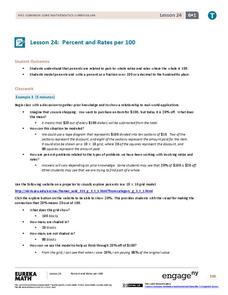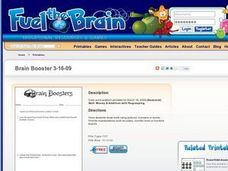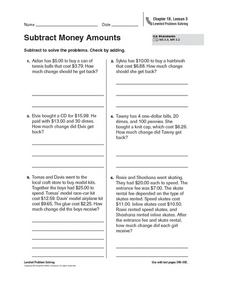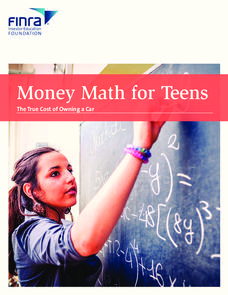Houghton Mifflin Harcourt
Sums to 100
Whether it's counting marbles, flowers, or playing cards, small objects can add up to great sums. Learners work six story problems to practice addition to 100. Some regrouping is required, along with distinguishing useful from irrelevant...
Curated OER
Interpret Graphs of Ordered Pairs
Middle and high schoolers solve four word problems based on three different graphs of ordered pairs which show the amount of money spent on lunch on particular days. Next, learners are given two equations of functions, and an x value and...
EngageNY
Percent and Rates per 100
What percentage of your class understands percents? Pupils learn the meaning of percents based upon rates per 100 in the 24th lesson in a series of 29. They represent percents as fractions, decimals, ratios, and models. The scholars...
EngageNY
Estimating Centers and Interpreting the Mean as a Balance Point
How do you balance a set of data? Using a ruler and some coins, learners determine whether the balance point is always in the middle. Through class and small group discussions, they find that the mean is the the best estimate of the...
Houghton Mifflin Harcourt
Write and Evaluate Algebraic Expressions
Once your math class is adept at writing expressions, challenge them with a few word problems! There are six real-world scenarios for which learners must come up with a representative variable expression. Take CCSS.Math.Content.6.EE.2.a...
K5 Learning
The Story of a Wise Woman
The Story of a Wise Woman tells the tale of South Carolina's, Eliza Lucas Pinckney and how she persevered to plant and harvest indigo. With this short story and questions worksheet, your early readers test their comprehension with four...
Macquarie University
Logarithms and Exponentials
Introduce logarithmic functions and their properties with a straightforward lesson plan. It provides an introduction to new material, examples, and practice problems. The variety of problem types keeps learners engaged while practicing...
Curated OER
Practice Regrouping with 10 to 14
In this subtraction with regrouping activity, learners learn to solve the subtraction word problems using regrouping. Students learn to regroup with the numbers 10 to 14.
Curated OER
The Math Lesson 45
In this division practice activity, students use their problem solving skills to solve 278 problems that require them to divide in word problem and regular problems.
Curated OER
Ratio and Proportion: Basic Operations and Applications
Learners explore example problems dealing with ratios and proportions. Afterward, they read story problems and solve them using ratios and proportions. This four-page worksheet contains six multi-step problems.
Fuel the Brain
Brain Boosters-Money & Addition with Regrouping
If a leprechaun finds 39 cents, what are the possible coin combinations? A St. Patrick's Day math activity is a great way to keep the class excited about the holiday, but also keeps them focused on the math lesson too. By using addition...
Curated OER
The Value of Education
The real value of education is highlighted in more than one way on a worksheet designed to not only add, subtract, multiply, and divide decimals to hundredths, but also to address the correlation between higher pay with accomplishing...
Balanced Assessment
Stock Market
Analyze trends in the stock market using histograms. Future economists use data presented in a histogram to find periods of greatest increase and decrease. They also draw conclusions about days that would be best to invest.
Curated OER
Act it Out
In this money worksheet, students solve 5 word problems where they are given an amount of money in written form and make a list to help organize the information in order to add the coin values. Students make change in 4 of the problems.
Curated OER
One Dollar
In this money practice learning exercise, students sharpen their problem solving skills as they solve 6 story problems that involve sums of 1 dollar.
Federal Reserve Bank
Retirement Planning
It's never too early to start saving for retirement. In fact, the earlier one starts, the better! Use this retirement planning activity to teach the importance of a retirement strategy and why to start at a young age.
Curated OER
Hands On: Relate Fractions, Decimals, and Money
In this fractions learning exercise, students solve 6 problems in which a story that compares two amounts of money is first read. Students determine which amount is greater. Students will be comparing decimals with fractions.
Curated OER
Subtract Money Amounts
In this subtracting money amounts worksheet, students subtract the money amounts within the word problems. Students solve six word problems.
Curated OER
Multiply Money
In this multiplication practice worksheet, students sharpen their problem solving skills as they solve 6 story problems that require them to multiply money.
Curated OER
Add Mixed Numbers with and without Regrouping
In this adding mixed numbers with and without regrouping worksheet, students sharpen their problem solving skills as they solve 6 story problems.
SaveandInvest.org
The True Cost of Owning a Car
Almost every teen wants a car, but can they really afford one? The lesson walks pupils through how to identify a budget, find all of the costs associated with car ownership, and determine if they should buy the car or keep looking.
Curated OER
A Lifetime of Savings
Sometimes people who seem to lead what would be considered an ordinary life do extraordinary things. Such was the case with Oseola McCarty, who donated a large sum of money for a university scholarship fund in her name. Oseala lived her...
EngageNY
Comparison Shopping—Unit Price and Related Measurement Conversions II
Which rate is greater and by how much? Pupils continue to compare rates to solve problems in the 20th portion of a 29-part series. Rates are presented in a variety of representations either using the same representation or different...
Illustrative Mathematics
Walk-a-thon 1
Your mathematician's job is to explore the relationship between hours and miles walked during a walk-a-thon. The activity compels your learners to experiment with different means in finding out this proportional relationship. The answer...

























